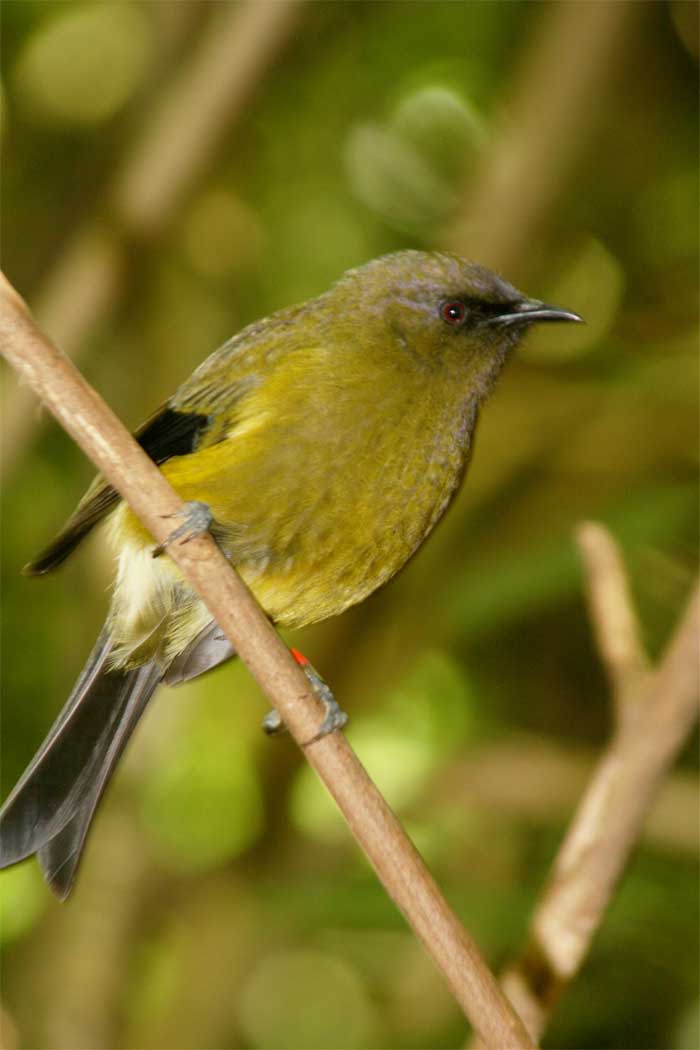
Anthornis melanura (*)
Superregnum: Eukaryota
Cladus: Unikonta
Cladus: Opisthokonta
Cladus: Holozoa
Regnum: Animalia
Subregnum: Eumetazoa
Cladus: Bilateria
Cladus: Nephrozoa
Superphylum: Deuterostomia
Phylum: Chordata
Subphylum: Vertebrata
Infraphylum: Gnathostomata
Megaclassis: Osteichthyes
Cladus: Sarcopterygii
Cladus: Rhipidistia
Cladus: Tetrapodomorpha
Cladus: Eotetrapodiformes
Cladus: Elpistostegalia
Superclassis: Tetrapoda
Cladus: Reptiliomorpha
Cladus: Amniota
Classis: Reptilia
Cladus: Eureptilia
Cladus: Romeriida
Subclassis: Diapsida
Cladus: Sauria
Infraclassis: Archosauromorpha
Cladus: Crurotarsi
Divisio: Archosauria
Cladus: Avemetatarsalia
Cladus: Ornithodira
Subtaxon: Dinosauromorpha
Cladus: Dinosauriformes
Cladus: Dracohors
Cladus: Dinosauria
Ordo: Saurischia
Cladus: Eusaurischia
Subordo: Theropoda
Cladus: Neotheropoda
Cladus: Averostra
Cladus: Tetanurae
Cladus: Avetheropoda
Cladus: Coelurosauria
Cladus: Tyrannoraptora
Cladus: Maniraptoromorpha
Cladus: Maniraptoriformes
Cladus: Maniraptora
Cladus: Pennaraptora
Cladus: Paraves
Cladus: Eumaniraptora
Cladus: Avialae
Infraclassis: Aves
Cladus: Euavialae
Cladus: Avebrevicauda
Cladus: Pygostylia
Cladus: Ornithothoraces
Cladus: Ornithuromorpha
Cladus: Carinatae
Parvclassis: Neornithes
Cohors: Neognathae
Cladus: Neoaves
Cladus: Telluraves
Cladus: Australaves
Ordo: Passeriformes
Subordo: Passeri
Infraordo: Corvida
Superfamilia: Meliphagoidea
Familia: Meliphagidae
Genus: Anthornis
Species: Anthornis melanura
Subspecies: A. m. dumerilii - A. m. incoronata - A. m. melanocephala - A. m. melanura - A. m. obscura - A. m. oneho
Name
Anthornis melanura (Sparrman, 1786)
References
Museum Carlsonianum fasc.1 no.v
Vernacular names
беларуская: Мёдасмок-званочак
English: New Zealand Bellbird
magyar: Csengőmadár
lietuvių: Korimaka
Māori: Korimako
The New Zealand bellbird (Anthornis melanura), also known by its Māori names korimako, makomako, and kōmako, is a passerine bird endemic to New Zealand. It has greenish colouration and is the only living member of the genus Anthornis. The bellbird forms a significant component of the famed New Zealand dawn chorus of bird song that was much noted by early European settlers. The explorer Captain Cook wrote of its song "it seemed to be like small bells most exquisitely tuned".[2] Its bell-like song is sometimes confused with that of the tūī. The species is common across much of New Zealand and its offshore islands as well as the Auckland Islands.
Description
Males are olive-green with a dark purplish sheen on their head and black outer wing and tail, while females are a duller olive-brown with a blue sheen on the head and yellowish-white curving from the base of the bill to below the eye. Both have a notably red eye. They are about 17–20 cm from the tip of their beak to the end of their tail. Females weigh about 25 g and males 32 g. Juvenile females have brown eyes and a light yellow cheek stripe. Juvenile males have dull brown-black outer wing and tail feathers.[3]
Classification
There are four subspecies: A. melanura melanura, A. melanura dumerii, A. melanura oneho, and A. melanura obscura. The Chatham bellbird, A. melanocephala, which became extinct in the early 20th century, was formerly classified as a subspecies of the New Zealand bellbird, as A. melanura melanocephala.
Distribution
Image of New Zealand Bellbird feeding on honeydew on the trunk of a mountain beech tree. Craigeburn Forest.
New Zealand bellbird feeding on honeydew on the trunk of a mountain beech tree. Craigeburn Forest.
The bellbird is found throughout both the main islands of New Zealand apart from the north of the North Island. Its population and distribution had been seriously affected by the introduction of European-style farming, which has led to the removal of native forests (the natural habitat of the bellbird). Another important factor is the introduction of predatory species such as cats, weasels, stoats, ferrets, rats, and food-robbing species like wasps. Predators either eat the birds or consume eggs, while food robbers compete with the bellbird for its natural food sources of nectar, honeydew and insects. The decline occurred around the same time as that of many other New Zealand species, but for unknown reasons was reversed and the species is still common across much of New Zealand.[4]
Behaviour
Bellbird feeding from flax flowers, note the pollen on its forehead which will help pollinate other flowers
Breeding
Breeding occurs from September to January where two broods can be produced. Their nesting habits are similar to the tui in respect to colour of eggs, clutch size and incubation.[5] They generally lay three to four eggs with pinkish brown spots and blotches.
Diet
Bellbirds feed on nectar, fruit and insects. Insects are important for females and their chicks during the breeding season. As honeyeaters, with brush-tipped tongues that enable them to sip nectar and the honeydew found on the trunks of beech trees,[6] they play an important part in pollinating numerous native plants such as mistletoe, fuchsia, and kowhai.[7]
Song
Bellbird song consists of three distinct sounds similar to the sound of chiming bells. They sing during the day but more in the early morning and late evening. Their alarm call is a repeated set of harsh staccato notes,[7] similar to a blackbird. The call of the Anthornis melanura is used by Radio New Zealand as an interval signal.
References
BirdLife International (2017). "Anthornis melanura". IUCN Red List of Threatened Species. 2017: e.T22704447A110985953. doi:10.2305/IUCN.UK.2017-1.RLTS.T22704447A110985953.en. Retrieved 13 November 2021.
Cook, James. The Three Famous Voyages of Captain James Cook Round the World. London: Ward, Locke and Company. p. 165.
North, Heather. "Bellbird (Korimako) identification leaflet" (PDF). Archived from the original (PDF) on 2010-05-17. Retrieved 2011-08-22.
Bartle J & Sagar P (1987) "Intraspecific variation in the New Zealand Bellbird Anthoris melanura. Notornis 34 253-306
Bellbird - Te Ara Encyclopedia of New Zealand Retrieved: 13 February 2011
Moon, Lynnette. (2006). Know your New Zealand-- birds. Moon, Geoff. Auckland, N.Z.: New Holland. ISBN 9781869660895. OCLC 166309733.
Bellbird/korimako facts - Department of Conservation Archived 2012-10-05 at the Wayback Machine Retrieved: 13 February 2011
Further reading
Higgins, P.J.; Peter, J.M.; Steele, W.K., eds. (2001). "Anthornis melanura Bellbird" (PDF). Handbook of Australian, New Zealand and Antarctic Birds. Volume 5: Tyrant-flycatchers to chats. Melbourne: Oxford University Press. pp. 1173–1191. ISBN 978-0-19-553258-6.
Retrieved from "http://en.wikipedia.org/"
All text is available under the terms of the GNU Free Documentation License

